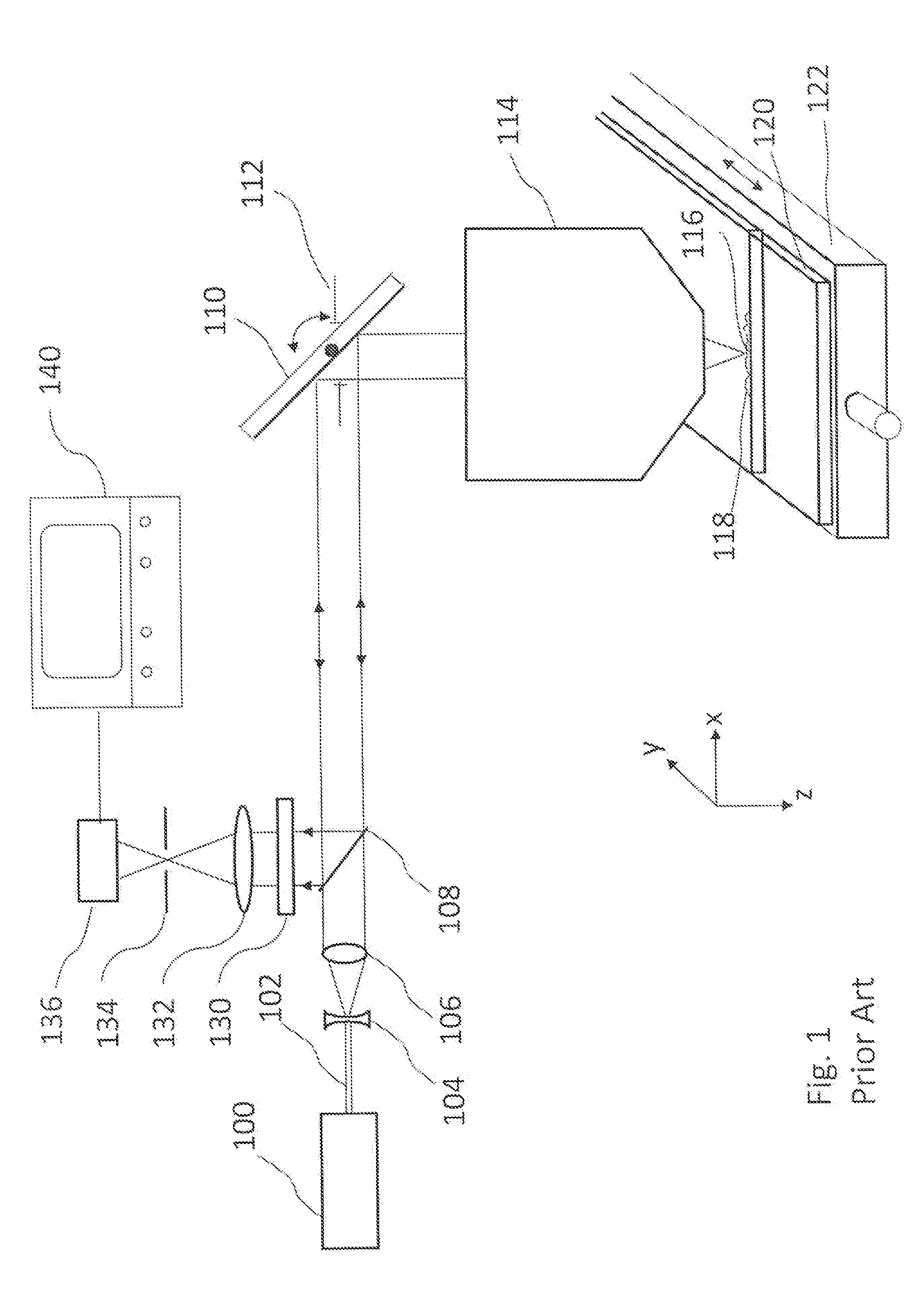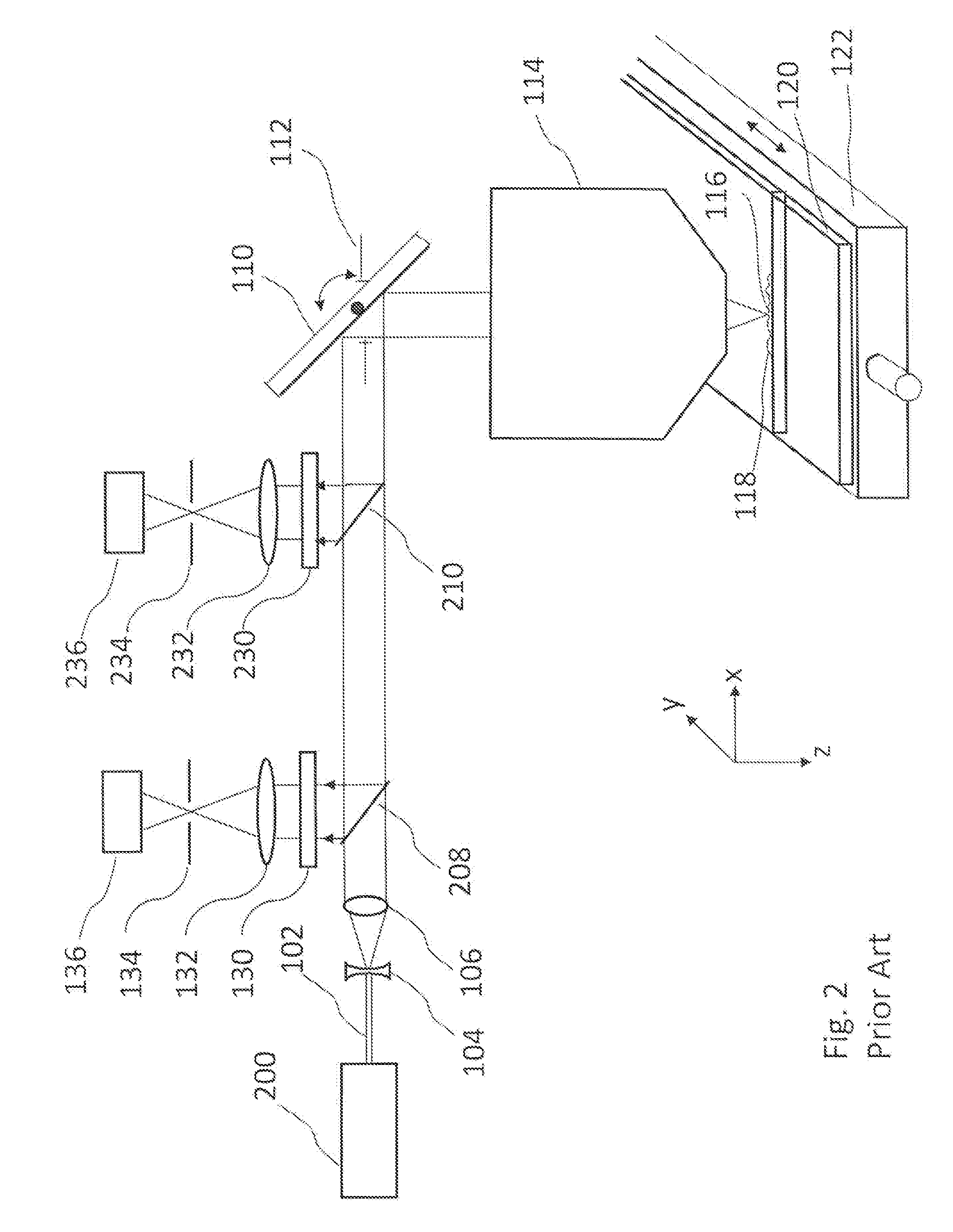Confocal fluorescence slide scanner with parallel detection
- Summary
- Abstract
- Description
- Claims
- Application Information
AI Technical Summary
Benefits of technology
Problems solved by technology
Method used
Image
Examples
first embodiment
[0047]FIG. 4 shows a confocal scanning-beam / scanning-stage optical macroscope with two illumination / defection arms that is this invention.
[0048]In this embodiment, a first incoming collimated laser beam 402 from laser 400 passes through a beam expander (comprised of lens 404 and lens 406), and is expanded to match the diameter of entrance pupil 112 of scan lens 414 (note—entrance pupil 112 as indicated on Figure simply indicates the position of the entrance pupil of scan lens 414. A real stop is not placed at this position). Scanning mirror 110 deflects the beam to move the scanning spot in the X direction. Scan lens 414 focuses the beam to spot 418 on specimen 415, mounted on microscope slide 120, and light reflected from or emitted by the specimen is collected by scan lens 414, descanned by scanning mirror 110, and partially reflected by beamsplitter 408 into a first confocal detection arm comprised of laser rejection filter 430, lens 432, pinhole 434, and detector 436. Detector 4...
second embodiment
[0057]FIG. 5 shows a confocal scanning-beam / scanning-stage optical macroscope with a single illumination arm transmitting light from two separate light sources, and two defection arms, one for light emitted from each focused spot on the specimen that is this invention. In this embodiment, light from a first light source 500 passes through a small-diameter fiber optic cable 502 attached to holder 504 that holds the end of the fiber at position 506 on the focal plane of lens 106. Light from the fiber expands to fill lens 106, resulting in a parallel beam of light moving toward a beamsplitter 507 that partially reflects the beam towards scanning mirror 110. After reflection from the scanning mirror, the parallel beam is focused by scan lens 414 onto specimen 415 at focus spot 516. Specimen 415 is mounted on microscope slide 120 (or other specimen holder), and light reflected from or emitted by the focus spot 516 on the specimen is collected by scan lens 414, descanned by scanning mirro...
third embodiment
[0066]FIG. 6 shows a confocal scanning-beam / scanning-stage optical macroscope with a single illumination arm transmitting light from two separate light sources, and a single detection arm containing two detectors, one for light emitted from each focused spot on the specimen that is this invention. In this embodiment, light from a first light source 500 passes through a small-diameter fiber optic cable 502 attached to holder 504 that holds the end of the fiber at position 506 on the focal plane of lens 106. Light from the fiber expands to fill lens 106, resulting in a parallel beam of light moving through beamsplitter 610 toward the scanning mirror 110 which is focused by scan lens 414 onto specimen 415 at focus spot 516. Specimen 415 is mounted on microscope slide 120 (or other specimen holder), and light reflected from or emitted by the focus spot 516 on the specimen is collected by scan lens 414, descended by scanning mirror 110, and partially reflected by beamsplitter 610 info a ...
PUM
| Property | Measurement | Unit |
|---|---|---|
| Diameter | aaaaa | aaaaa |
| Distance | aaaaa | aaaaa |
| Wavelength | aaaaa | aaaaa |
Abstract
Description
Claims
Application Information
 Login to View More
Login to View More - R&D
- Intellectual Property
- Life Sciences
- Materials
- Tech Scout
- Unparalleled Data Quality
- Higher Quality Content
- 60% Fewer Hallucinations
Browse by: Latest US Patents, China's latest patents, Technical Efficacy Thesaurus, Application Domain, Technology Topic, Popular Technical Reports.
© 2025 PatSnap. All rights reserved.Legal|Privacy policy|Modern Slavery Act Transparency Statement|Sitemap|About US| Contact US: help@patsnap.com



